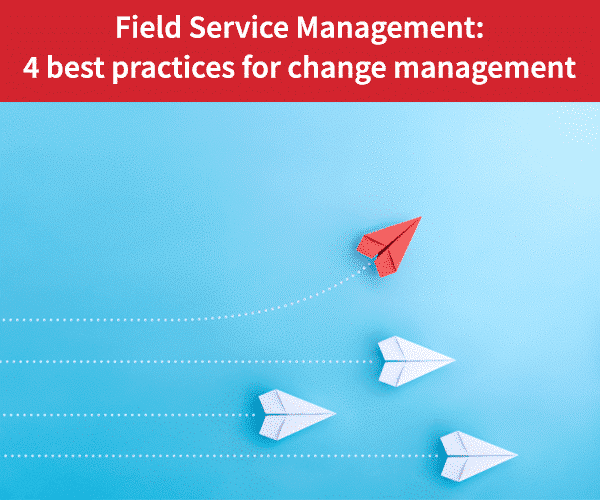
- Field Service Management
- Gestion d’interventions
- Logiciel
- Productivity
- Software
Field service management: 4 best practices for change management
Familiarizing users with the project, communicating about benefits of the change, and training the teams …. These are just some of the change management prerequisites for the successful deployment of field service management software.
As powerful as it is, software is useless if it’s not used! A truism to be sure, but it should be remembered. Too many IT projects fail because they are approached solely from a technical point of view, leaving users behind.
What’s more, active leadership through change is indispensable because the new approach affects internal processes, as well as redefining the roles of operational and managerial staff. On top of that, a new field service management solution changes the way planners work as the field technicians.
Almost by definition, new software typically receives a lukewarm or even unfavorable reception. These responses align with the well-known adoption curve — the curve that starts with “resistance to change”. One user misses the drop-down menus of the old system, whereas another laments its reduction in functional scope. As a result, the new tool may be underused or even boycotted.
To engage all employees, one must be able to demonstrate that change is inevitable while, at the same time, building a climate of trust. The message here is that we’re not changing for the sake of change but to improve the organization for the benefit of all. Indeed, as the driver of this change, the management team must become the project’s main sponsor.
Popularized during major IT projects of the 1990s, change management best practices have become commonplace so as to win the support of users. It is estimated that change management resources represent 5% to 10% of the project budget but that this investment increases the odds of success by 50%.
1 / Familarize users with the choice of the solution
To accept the idea of change, free-flowing feedback is necessary. Working groups should be established to highlight the hopes, wishes and understanding of the project. Within these groups, teams should be allowed to discuss freely among themselves without managerial pressure.
Another good practice is to familiarize users with the solution. They can become members of a representative panel of “ambassadors” comprised of volunteers from the various functional teams. Because these volunteers have worked daily using the processes slated for automation, they are ideally positioned to identify the essential features of the new solution.
These same users can test the solution before deployment. Based on their feedback, optimization, and refined customization of the tool will be possible. Among other things, the goal is to hunt for bugs, as well as irritants so the user experience is as satisfying as possible.
2 / Communicate the benefits of the solution
To avoid tunnel vision and maintain morale, stakeholders need to be regularly informed about the project’s progress. This communication should highlight the benefits of the solution to users, including new features, time saved in certain tasks, and the ergonomics of the interface. The message should be adapted to the needs and interests of the audience.
For field service management planners, everyday life will be simplified. With next-generation field service management software, a planner will be able to move or change a technician’s field service call, or assign it to another technician all with drag-and-drop actions. Using artificial intelligence algorithms, the planner can also take advantage of the best possible planning options, while taking into account all operational constraints.
The advantages of mobility and digital solutions
From a smartphone or tablet, the field technician can see the latest version of their schedule and can be notified when a change occurs. Optimizing work order planning also reduces travel time — a significant source of stress. What’s more, freed up from administrative tasks, the planner can enter the work order report using the same mobile device.
In the same way, accounting department staff can go paperless, avoiding manual data entry. Furthermore, the ERP or accounting software can be interfaced with the field service management software to trigger associated billing by automatically retrieving work times, the services provided, as well as the spare parts used.
Equally important, it is important to communicate with clients (internal or external) about the service. The new software should change the way incident tickets are created, work order monitoring, as well as the measurement and reporting of quality indicators.
3 / Train users according to their profiles
Even if the selected software is particularly intuitive, training sessions early on will speed adoption. To avoid knowledge gaps, the training should be given shortly before launch. More specifically, it is advisable to use e-learning for the theoretical component and face-to-face training for implementation.
Content presented in a game-like way can also improve online training. Video tutorials and interactive quizzes will attract more attention than a succession of PowerPoint slides. In addition, serious games that use video game code are particularly attractive to millennials.
On top of that, to meet the job constraints of the technician on site — who is always on the road! — it makes sense to offer micro-training designed to be delivered on mobile devices.
4 / Make an initial assessment without hiding the difficulties
On Day One of the transition to the new software, the technical support team must be mobilized to answer all user requests and questions. A few months after the launch, the company will be in a better position to make an initial assessment. Typically, the first results obtained will encourage further change.
Avoid embellishing the results or trumpeting a “success story”. This first assessment must remain factual and be based on key indicators recognized by all.
To reinforce the gains and increase the rate of adoption, booster shots should be applied to training. It is also possible to set up user communities on collaborative platforms using the intranet or a corporate social network to exchange advice and best practices.
Our similar articles.
-
- Field Service Management
- Internet of Things
- Work Order Management
- Gestion d’interventions
- Technologies
- Analytics
5 ways Artificial Intelligence is making Field Service Management smarter (Part 2)
April 12, 2018 -
- Software
- Field Service Management
- fsm
- cmms
Telecoms Crossroads: challenges & opportunities in the era of digital transformation
July 24, 2023 -
- Field Service Management
- Maintenance
- Gestion d’interventions
- HVAC
Why maintenance for air conditioners is increasingly important
June 8, 2022


